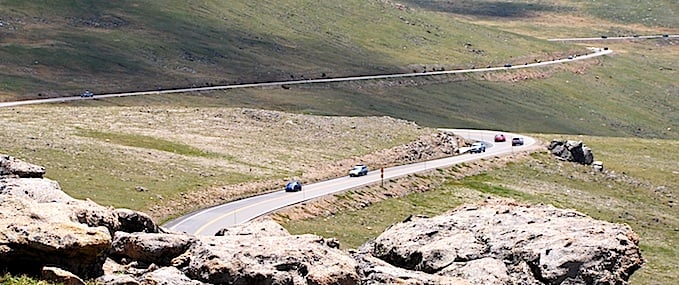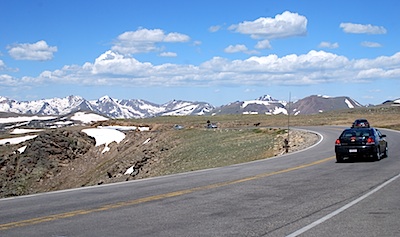
Trail Ridge Road in Rocky Mountain National Park offers no guardrails to keep you from plunging off the mountainside. Kurt Repanshek photo.
Driving Trail Ridge Road in Rocky Mountain National Park is not for those who suffer vertigo. No guardrails will stop your vehicle if you edge off the pavement, and the flanks of the mountains drop away quickly, and steeply.
As the road carves its serpentine path across the park's roof, rising past 12,000 feet in elevation, it can be a struggle to keep your eyes on the pavement in front of you, and not veering to those monstrous dropoffs. And yet, according to park officials, there have been very few fatal accidents along Trail Ridge Road.
"We have a few motor vehicle accidents a year along Trail Ridge Road, but few are fatal," says Rocky Mountain spokeswoman Kyle Patterson. "The last fatality on Trail Ridge Road was in 1995 when two young men drove off near Rock Cut in a bad spring storm."
Why are there no guardrails along the road? The Federal Highway Administration addressed that topic in the "barriers" section of the Trail Ridge Road Safety Study completed back in 2004:
Due to the steep slopes and rigid objects along most of the roadside, barrier is warranted along the majority of the roadway. However, there are several reasons why this is not recommended.
First, there are very few accidents occurring where guardrail or stone masonry wall would result in less injuries and property damage for the motorists. The crashes involving motorcycles would likely result in worse injuries if a barrier were in place. Outside of the alpine areas, vehicles that run off the roadway are generally stopped a short distance from the roadway by trees and due to the low speeds there are relatively minor injuries. If a barrier on this curvy road had redirected these vehicles, it is quite likely they would go across the other lane of traffic and possibly have a more serious accident or involve an innocent bystander in the crash.

Spectacular scenery can make it a challenge to keep your eyes on the road. Kurt Repanshek photo.
With barriers on both sides of the road, they may ricochet back and forth across the lanes before coming to a stop. In the alpine section where the need appears greatest because of the sheer distance down the steep slopes, there are very few run-off-road accidents. This may be due in part to the extra care that drivers take due to the fear instilled by the sight of these slopes.
Second, the views from the roadway would be partially blocked by the barrier. Considering that the main purpose of this roadway is to provide tourists with the amazing vistas of this area, blocking views would take away from the very purpose of this road. This is not to say that blocking a view is more important than providing a safe roadway, but that installing barrier along both sides of the entire length of this roadway would not be worth the trade-off. (Trail Ridge Road was designated by the U.S. Secretary of Transportation as an All-American Road, the highest level of designation, in 1996. It is one of eleven America’s Byways® designated in Colorado).
Third, the cost and environmental impacts would be great. Because barrier by its very nature requires a wider roadway footprint, the cost of installing barrier on this narrow roadway would require retaining walls along most of the fill slopes. In addition, it was noted that many of the areas that most warrant barrier are areas that are already narrow with very steep slopes that extend for hundreds of feet.

 Support Essential Coverage of Essential Places
Support Essential Coverage of Essential Places







Comments
Just made the trek up to the visitor center. I agree that it is a terrifying ride and I could not even enjoy the scenery while driving. I was so relieved when we made it down. Visitor from the Midwest.
I totally agree. Ouray to Silverton on U.S. 550 definitely has its moments.
Having grown up in Northern Colorado I've been on Trail Ridge literally dozens of times since my youth, and I've never taken for granted what a serious drive this is. If these comments give you pause, you might want to skip it- there's plenty more to enjoy in RMNP without putting yourself in a bad situation.
If this is you, here are some other roads in the state to avoid: Pike's Peak, Mt Evans, the OMG road (yes, that's right) Wolf Creek Pass, Million Dollar Highway (including Red Mountain Pass) and plenty more, and I'm not even including any number of terrifying off road trails like Black Bear Pass or Mt. Princeton.
Here's a bonus tip for anyone who does decide to go up above timberline: if you see dark clouds start to gather, or hear any thunder, get down and preferably off the mountain ASAP. Far too many people get struck by lightning in our state, and it's mostly avoidable. Be safe!
Not slow enough! I've driven it several times. I feel luckt to survive it each time!
That's rude. These phobias are very real to those who suffer them.
VERY slow! 20-30 mph and some switchbacks are even slower.
Don't feel ashamed, If you made it to the top you are braver than me. I turned around at 11,000 feet. The altitude sickness didn't help either
I go like 5-10 miles under the speed limit sorry its so scary